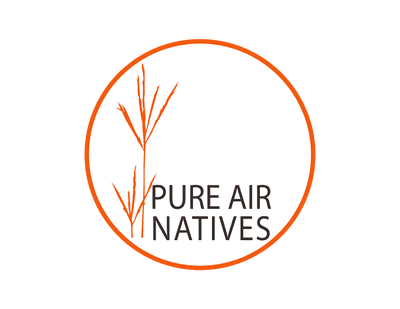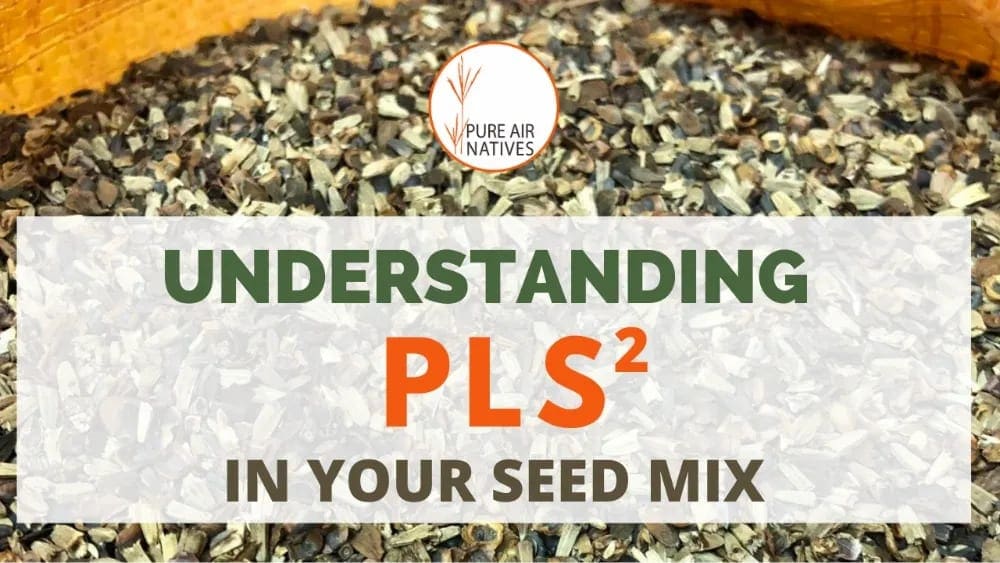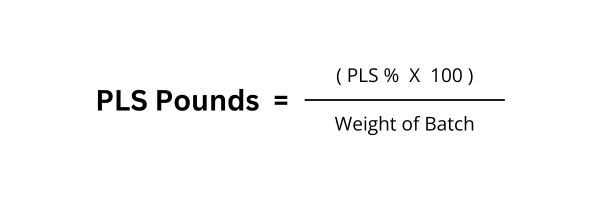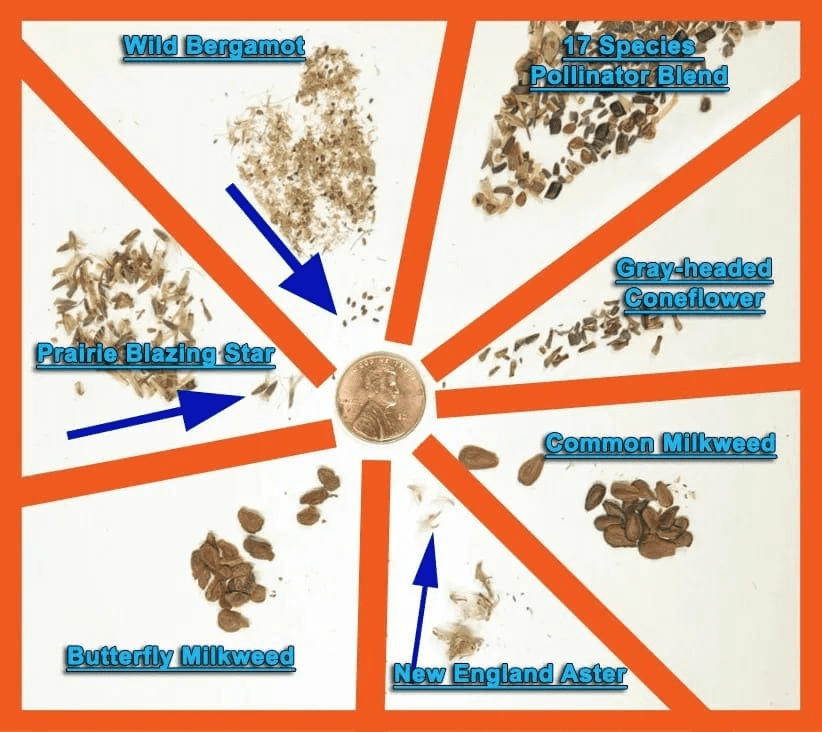On our website, you may have noticed that all of our seed is certified PLS seed. For those not used to the native seed industry lingo, this may seem confusing. After all, aren’t native seeds just native seeds? Is PLS seed just a marketing gimmick? What’s the difference, anyways?
Our short answer? No. Not all native seeds are sold equally.
So whether you’re interested in seed packets, bulk seed, or seed mixes, let’s dive into what PLS seed means and how it impacts you and leaves more money in your wallet.
What Is Pure Live Seed (PLS)?
Pure Live Seed (PLS) is a ratio used to determine the percentage of live seed in a batch that is expected to germinate. Simply put, it ensures guaranteed germination rates, crucial for successful planting projects.
Each batch of seed undergoes its own PLS calculation. And just like any planting project, the success of your native habitat relies on seed quality, planting techniques, and using the correct type and amount of seed.
PLS vs. Traditional Bulk Seed Purchases: Why It Matters
Buying seeds is an investment, but not all seeds will grow into seedlings. The PLS ratio addresses this uncertainty, ensuring that you receive the amount of seeds you ordered seeds capable of germination. In other words, when you buy one pound of PLS seed, you will receive at least 1 pound of seeds that are guaranteed to germinate.
However, traditional bulk buying often overlooks this critical factor, resulting in overpayment for seeds with uncertain germination rates due to environmental variations. This can lead to frustration, leading customers to overpay and companies to underdeliver.
Bargain bulk seed with a low PLS percentage can end up costing more to properly seed a project compared to higher-priced seed with a higher PLS percentage (see our chart below). Many online seed retailers fail to disclose the percentage of seeds guaranteed to grow, leaving customers uninformed about their purchases.
While this might not be a big concern for small-scale purchases like native seed packets, larger projects requiring over 10 pounds of seeds can quickly accumulate lots of unnecessary costs and waste. It’s surprising to discover the amount of ineffective seeds, such as dirt, weeds, dead seeds, and irrelevant native species that people pay for in their bulk purchases.
At our shop, all of our native grass and wildflower seed mixes are sold in Pure Live Seed (PLS). This ensures that you’re only paying for seeds that will germinate, without paying for ‘inert matter’ and other non-germinating seeds, especially when buying in bulk. While inert matter will still be included, you won’t pay for it, saving you money and ensuring the success of your planting project.
Testing & Certification Process
When we receive a shipment of native seeds from our farms or a trusted third party supplier, we ship it off to a 3rd party laboratory to test for germination rates & purity. The combination of germination rate and purity make up the PLS.
Once the lab confirms the purity and germination rates for the batch, we enter the PLS % into our inventory and sales system. When customers buy our native seeds or seed mixes, we plug in the quantity ordered into our PLS calculator and ensure the seeds bought or the mix we build contains the amount of viable seed they ordered.
PLS Formula & Calculation Table
Here’s how to calculate how much of each batch is classified as PLS. This is the calculation we do every time we receive a shipment (a batch) of seed from our farm or a trusted retailer:
Here’s an illustration that shows the differences between PLS seed and non-PLS seed:
| PLS Seed Vs. Non-PLS Seed Quantity Comparison | |
|---|---|
| PLS Percentage (%) | Pounds Needed for 1 PLS Pound (lbs) |
| 100 | 1 |
| 90 | 1.11 |
| 80 | 1.25 |
| 70 | 1.43 |
| 60 | 1.67 |
| 50 | 2 |
| 40 | 2.5 |
| 30 | 3.33 |
| 20 | 5 |
| 10 | 10 |
In summary, one pound of PLS seed is not equal to one pound of traditional seed because no harvest of seed is 100% viable. PLS accounts for this.
The next time you’re buying native seeds or mixes…pause and look for the PLS information. If it doesn’t show the purity percentage, then you’re likely not getting what you’re paying for. Instead, most of your money is going towards noxious weeds or dead seeds. If you’re not buying in PLS, then you’re missing out.
Building A PLS Seed Mix
Understanding PLS is crucial for bulk native seed purchases because it directly impacts the effectiveness and cost-efficiency of seeding projects. The USDA regulates native seeding rates in “seeds per square foot” (PLSft2), which is how many seeds are in a single square foot. There are 43,560 square feet in 1 acre.
For example, if you wanted 1 Butterfly Milkweed plant growing in every single square foot of your 1-acre planting site, you would need 43,560 PLS seeds in your 1-acre seed purchase.
Because seed is sold in pounds (or fractions of a pound), adding and removing seeds from a mix will change the price, but not always in the way you think. Some seeds are the size of powder while some are the size of a dime. These differences in size and weight can lead to differences in price between seed mixes due to the species used.
Here’s another example. Golden Alexander has 10,750 seeds per ounce, while Cardinal Flower has 705,797 seeds per ounce (like powder!). If you wanted 1 Golden Alexander plant growing in every single square foot of your 1-acre planting, you would need just over 4 ounces of seed. Whereas if you wanted 1 Cardinal Flower growing in every single square foot, you would need a small fraction of an ounce. In the infographic, you can see this example play out and how a more expensive seed can cost you less than if you were to use a less expensive seed in the mix. It doesn’t always work like this, however.
Interested In A Custom Seed Mix or Bulk Grass Seed?
Pure Air Natives only sells PLS seed, which means that you’re guaranteed to only be buying germination guaranteed seed. The more seed you buy, like with government subsidized seed mixes, the more important PLS becomes.
Custom creating a native seed mix is a calculated and time-consuming task. Understanding native plant communities, composition, soil types, climate conditions, desired customer goals, and other determinants; all get factored into creating our mixes. Simply adding, removing, or substituting a species can substantially alter the entire mix, both in price and long-term success.
If you’re enrolled in the CRP program and have been approved for a seed mix, contact us and send over the document you were given. We’ll send you a quote.
You won’t be paying for seeds that won’t germinate and establish, and we help home gardeners, large property owners, and CRP members efficiently help the environment.
Every time we make a mix, we must calculate the weight of seed species needed based on its PLS % to ensure you’re only paying for viable seed.
PLS Summary
Here’s a summary of PLS.




